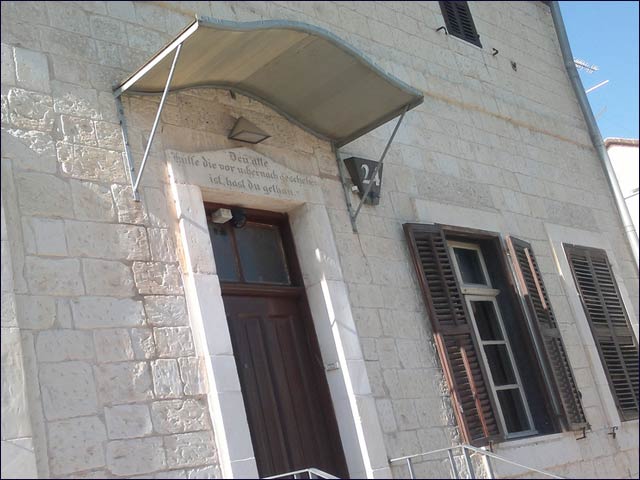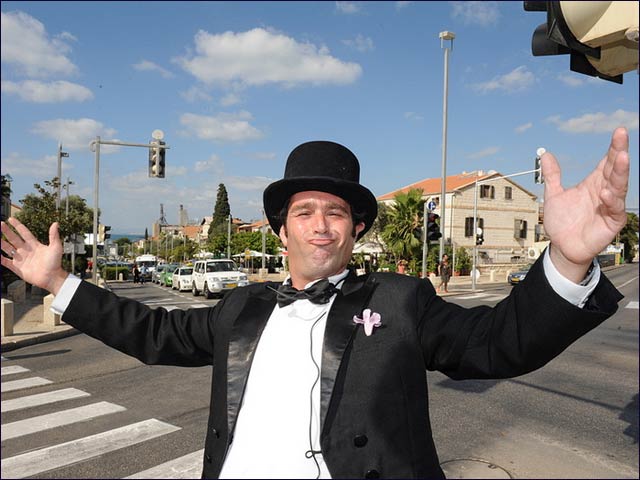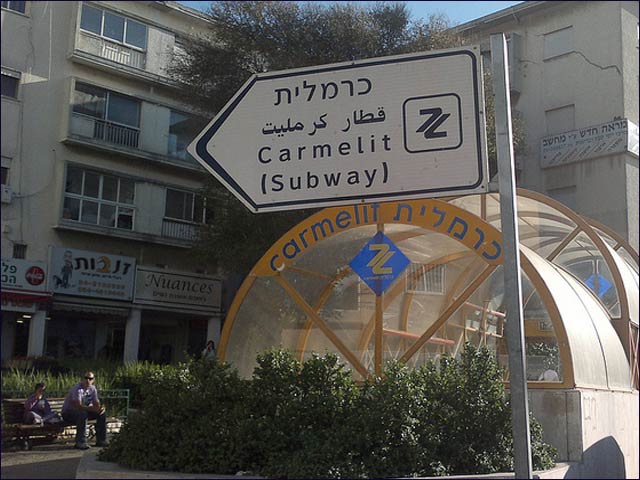By Avigayil Kadesh
Established as a small fishing village in the third century CE, Haifa is now Israel’s third-largest city (behind Jerusalem and Tel Aviv), a major port into and out of Israel. The unofficial capital of the North has been under Canaanite, Israelite, Roman, Byzantine, Arab, Crusader, Kurd, Mamluk, Ottoman and British rule over its long history, each leaving a mark on modern Haifa.
If you visit during the annual Holiday of Holidays in December celebrating Hannukah, Christmas and Ramadan (when it falls in December), it’s easy to see why Haifa is known as a model city of coexistence among Jews, Christians and Muslims – and also Baha’is, who don’t live in Haifa but revere it as their World Center.
December 2012 was the 19th year for the Holiday of Holidays, and the lampposts of the city were adorned with Christmas trees and menorahs.
“The beautiful mosaic of people that exists here in Haifa is famous for its open-mindedness,” says Jalal Hatami, deputy secretary-general of the Baha’i International Community. “Acceptance of the other is part of the culture of Haifa, and as Baha’is it makes us feel very much at home and we hope to contribute our share to continuing and growing this spirit in the city as thousands of people come from all over the country and the world to see our gardens.”

The main level of the Baha’i Gardens and shrine He is referring to the spectacular Baha’i Gardens , a UNESCO World Heritage site maintained by hundreds of visiting followers of the Baha’i faith each year, and toured by 15,000 people per week from across the world. Israel became the holy land for the Baha’is in the late 19th century when it was still under Ottoman rule, because the Báb, the Iranian successor prophet of the religion, was exiled to Haifa. His grave in nearby Acre (Akko), and that of the founder prophet, Bahá'u'lláh, at the pinnacle of the gardens, are Baha’i religious shrines.
The stepped gardens climb dramatically up the northern side of Mount Carmel, making them a focal point from many parts of the city – especially from the German Colony, a neighborhood established in the 1860s by a group of Templer Christians from Stuttgart. Haifa’s was the first of several German colonies they built in Israel, the most well-known of which are in Jerusalem and Tel Aviv .
In 1905, during the last years of the Ottoman Empire, a family called Appinger built a hotel for German pilgrims at the foot of what is now the Baha’i Gardens. Today it is a chic boutique hotel, the Colony .
“The hotel operated until 1948, when the British exiled the Templer Germans to Australia,” explains Avi Agajany, general manager of the Colony. “After Israel won independence from the British in 1948, a Holocaust survivor bought the hotel with the help of his brother. In 1978, it became a home for the elderly. We bought it six years ago, renovated it completely and opened four years ago.”
The restoration work retained many of the original windows, doors, patterned floor tiles and woodwork. On the walls hang framed photos of the Appinger family and nostalgia such as menus from the early 20th century.
More hotels coming
Like other hotels in Haifa, the Colony maintains an unusually high occupancy rate of about 80 percent, more than half of which is made up of foreign tourists. About a third of the tourists from abroad are coming for leisure vacations by air or cruise ship (in 2011, some 270,000 people docked in Haifa, and half of them chose to tour the city via free shuttle buses provided to cruise ship passengers). The other two-thirds of overseas visitors to Haifa are business travelers.

A restored original Templer buildingHaifa is a prime business travel destination because the city’s MATAM Industrial Park houses branch offices of 50 large national and international companies including Google, Intel, SanDisk, Qualcomm, Philips and Microsoft. Headquarters for IBM and other corporate giants are located in the Haifa area as well, and a new biotech center is opening soon. The city’s Technion-Israel Institute of Technology is also a draw for foreign academics, as is the University of Haifa.
“Because we have very high occupancy in our 1,400 hotel rooms, of which 1,000 are very good quality, we have many more planned,” says Danny Ronen, general manager of the Haifa Tourist Board .
In January, the Atlas boutique chain opened the new 55-room Bay Club Hotel in what used to be the mansion of the Ottoman governor.
“Within three years we will have another 500 rooms, and plan to double the number of rooms within five years,” says Ronen. “We plan to open a new road in the German Colony, and a new large port in Haifa Bay in the next two to four years, which will have restaurants and coffee shops.”
The Tourist Board markets Haifa as a home base for travelers to the north because new roads have made it easy to travel to popular tourist spots including Acre, Rosh Hanikra, Tiberias, Nazareth , the Sea of Galilee and Zichron Yaacov in less than an hour.
“We suggest staying here for three days and taking day trips to these other places, and as an incentive we offer a one-day tour with a bus and guide free of charge if tourists spend three days in Haifa,” says Ronen. “It is certainly easier than packing and unpacking.”
He reveals that many of the leisure tourists coming to Haifa are German Christians, Chinese tourists and business travelers.
“We have three twin cities in China and we work closely with them, so we receive many Chinese delegations for biotech and high-tech trade shows.”
International visitors have also come to Haifa in the past couple of years for special events such as the international sailing competition and the bowling championships of Europe. “We will host the European championships in bridge in 2014,” says Ronen. “Haifa is considered a cultural capital, so we have many cultural tourists.”
Cultural hot spots in Haifa
Culture is indeed alive and well in Haifa.
The Beit Hagefen Arab-Jewish Cultural Center, located in the predominantly Arab neighborhood of Wadi Nisnas on the edge of the German Colony, is a unique institution in Israel.
Executive Director Asaf Ron explains that Beit Hagefen was established 49 years ago and uses culture, art and education as a means of bringing together diverse populations.
Beit Hagefen (House of Grapes) is so named because of the many vineyards that the Templers planted in the area to earn a living making wine. It is comprised of several buildings, including an Arabic-speaking theater, the Clore Children’s Library serving the Arab population around Haifa, and a contemporary art gallery in what used to be a kosher hotel built in 1905.
The center initiates projects to bring together artists from different religions, and programs such as Arab-Jewish hiking trips.
"We educate people toward tolerance,” says Ron. “It’s easier to bring people together around art and culture than around debate. The conflict is always on the table, but after meeting someone through art or culture and getting to know them as a person, it’s easier to discuss the core conflict issues.”
Beit Hagefen plays a central role in the annual Holiday of Holidays festival. Ron shows visitors around art installations in shared public spaces throughout the Wadi Nisnas neighborhood. “The center also sponsors a yearly Arab Culture Month, in which we try to strengthen Arab culture in Israel and encourage young painters, performers and artists, to expose their work to greater Israel,” he says.
It is estimated that Israeli-Arabs constitute about 10% of Haifa's population.
Organized tours of the city
The Haifa Tourist Board offers a variety of themed, guided tours for adults and children throughout the city to give visitors a deeper understanding of Haifa’s past and present. See the website for registration details or call 1-800-30-50-90 when in Israel.
Magic of the Colony, led by magician-mentalist Yoni Aladini, entertains and surprises participants while relating the local history of the German Colony from the perspective of Templer workers who built wagons and giant wheels for horse carts. It includes the former Appinger Hotel, Sir Lawrence Oliphant's “haunted house,” a former soap factory and dairy, and Templer buildings that housed a bank, post office and other communal structures. The tour takes about two hours.

The Haifa Tourism Board offers a range of costumed,
guided tours of the city There is a culinary tour of Haifa led by actors posing as French chefs, providing the answers to questions such as: Which coffee house will prepare a custom mixture for patrons? Can you eat and talk at Bracha's? Which restaurant doesn't allow any peeking into the pots? How can you experience a triple derby?
A dramatized tour of the German Colony is guided by actors in 1882 period costume, who introduce participants to some of the personalities who created the colony's atmosphere, such as Naphtali Herz Imber, author of Israel’s national anthem; Gottlieb Shumacher, the colony's architect, and colony leaders Elise and Sir Lawrence Oliphant.
The City Tour route includes many of the significant tourist attractions in Haifa: the breathtaking Mediterranean view from the observation point of the Louis Promenade, the upper terrace of the Baha’i Gardens, the Stella Maris Carmelite Church on Mount Carmel, the German Colony and Wadi Nisnas. This is a four-hour walking tour.
 Haifa has Israel’s only subway system
Haifa has Israel’s only subway system The 360-Degree Tour of Haifa is a free panoramic tour of the most beautiful observation points in the city, including the Louis Promenade. It leaves every Friday between 9:30 a.m. and 1 p.m.
If you prefer to travel around by yourself, Haifa boasts Israel’s only (so far) subway system, the Carmelit -- the world’s shortest underground transit route.